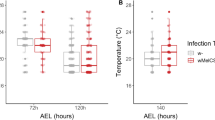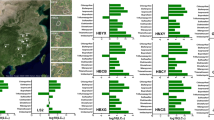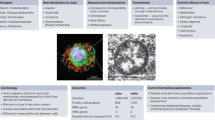Abstract
The interactions between insects and their bacterial symbionts are shaped by a variety of abiotic factors, including temperature. As global temperatures continue to break high records, a great deal of uncertainty surrounds how agriculturally important insect pests and their symbionts may be affected by elevated temperatures, and its implications for future pest management. In this study, we examine the role of bacterial symbionts in the brown planthopper Nilaparvata lugens response to insecticide (imidacloprid) under different temperature scenarios. Our results reveal that the bacterial symbionts orchestrate host detoxification metabolism via the CncC pathway to promote host insecticide resistance, whereby the symbiont-inducible CncC pathway acts as a signaling conduit between exogenous abiotic stimuli and host metabolism. However, this insect-bacterial partnership function is vulnerable to high temperature, which causes a significant decline in host-bacterial content. In particular, we have identified the temperature-sensitive Wolbachia as a candidate player in N. lugens detoxification metabolism. Wolbachia-dependent insecticide resistance was confirmed through a series of insecticide assays and experiments comparing Wolbachia-free and Wolbachia-infected N. lugens and also Drosophila melanogaster. Together, our research reveals elevated temperatures negatively impact insect-bacterial symbiosis, triggering adverse consequences on host response to insecticide (imidacloprid) and potentially other xenobiotics.
Similar content being viewed by others
Log in or create a free account to read this content
Gain free access to this article, as well as selected content from this journal and more on nature.com
or
References
Bálint M, Domisch S, Engelhardt CHM, Haase P, Lehrian S, Sauer J, et al. Cryptic biodiversity loss linked to global climate change. Nat Clim Chang. 2011;1:313–8.
Parmesan C, Yohe G. A globally coherent fingerprint of climate change impacts across natural systems. Nature. 2003;421:37–42.
Blois JL, Zarnetske PL, Fitzpatrick MC, Finnegan S. Climate change and the past, present, and future of biotic interactions. Science. 2013;341:499–504.
Haines A, Ebi K. The imperative for climate action to protect health. N. Engl J Med. 2019;380:263–73.
Deutsch CA, Tewksbury JJ, Tigchelaar M, Battisti DS, Merrill SC, Huey RB, et al. Increase in crop losses to insect pests in a warming climate. Science. 2018;361:916–9.
Kattwinkel M, Jan-Valentin K, Foit K, Liess M. Climate change, agricultural insecticide exposure, and risk for freshwater communities. Ecol Appl. 2011;21:2068–81.
Moe SJ, De Schamphelaere K, Clements WH, Sorensen MT, Van den Brink PJ, Liess M. Combined and interactive effects of global climate change and toxicants on populations and communities. Environ Toxicol Chem. 2013;32:49–61.
Potts SG, Biesmeijer JC, Kremen C, Neumann P, Schweiger O, Kunin WE. Global pollinator declines: trends, impacts and drivers. Trends Ecol Evol. 2010;25:345–53.
Moran EV, Alexander JM. Evolutionary responses to global change: Lessons from invasive species. Ecol Lett. 2014;17:637–49.
Harwood AD, You J, Lydy MJ. Temperature as a toxicity identification evaluation tool for pyrethroid insecticides: toxicokinetic confirmation. Environ Toxicol Chem. 2009;28:1051–8.
Guo L, Su M, Liang P, Li S, Chu D. Effects of high temperature on insecticide tolerance in whitefly Bemisia tabaci (Gennadius) Q biotype. Pestic Biochem Physiol. 2018;150:97–104.
Mao K, Jin R, Li W, Ren Z, Qin X, He S, et al. The influence of temperature on the toxicity of insecticides to Nilaparvata lugens (Stål). Pestic Biochem Physiol. 2019;156:80–86.
Verheyen J, Delnat V, Stoks R. Increased daily temperature fluctuations overrule the ability of gradual thermal evolution to offset the increased pesticide toxicity under global warming. Environ Sci Technol. 2019;53:4600–8.
Moran NA. Symbiosis as an adaptive process and source of phenotypic complexity. Proc Natl Acad Sci USA. 2007;104:8627–3863.
Kikuchi Y, Hayatsu M, Hosokawa T, Nagayama A, Tago K, Fukatsu T. Symbiont-mediated insecticide resistance. Proc Natl Acad Sci USA. 2012;109:8618–22.
Jones RM, Desai C, Darby TM, Luo L, Wolfarth AA, Scharer CD, et al. Lactobacilli modulate epithelial cytoprotection through the Nrf2 pathway. Cell Rep. 2015;12:1217–25.
Cheng D, Guo Z, Riegler M, Xi Z, Liang G, Xu Y. Gut symbiont enhances insecticide resistance in a significant pest, the oriental fruit fly Bactrocera dorsalis (Hendel). Microbiome. 2017;5:13.
Pang R, Chen M, Yue L, Xing K, Li T, Kang K, et al. A distinct strain of Arsenophonus symbiont decreases insecticide resistance in its insect host. PLoS Genet. 2018;14:e1007725.
Kikuchi Y, Tada A, Musolin DL, Hari N, Hosokawa T, Fujisaki K, et al. Collapse of insect gut symbiosis under simulated climate change. mBio. 2016;7:e01578–16.
Corbin C, Heyworth ER, Ferrari J, Hurst GDD. Heritable symbionts in a world of varying temperature. Heredity. 2017;118:10–20.
Jia FX, Yang MS, Yang WJ, Wang JJ. Influence of continuous high temperature conditions on Wolbachia infection frequency and the fitness of Liposcelis tricolor (Psocoptera: Liposcelididae). Environ Entomol. 2009;38:1365–72.
Burke G, Fiehn O, Moran N. Effects of facultative symbionts and heat stress on the metabolome of pea aphids. ISME J. 2010;4:242–52.
Fan Y, Wernegreen JJ. Can’t take the heat: high temperature depletes bacterial endosymbionts of ants. Micro Ecol. 2013;66:727–33.
Hussain M, Akutse KS, Ravindran K, Lin Y, Bamisile BS, Qasim M, et al. Effects of different temperature regimes on survival of Diaphorina citri and its endosymbiotic bacterial communities. Environ Microbiol. 2017;19:3439–49.
Engl T, Eberl N, Gorse C, Krüger T, Schmidt THP, Plarre R, et al. Ancient symbiosis confers desiccation resistance to stored grain pest beetles. Mol Ecol. 2018;27:2095–108.
Zhang XJ, Yu XP, Chen JM. High Temperature effects on yeast-like endosymbiotes and pesticide resistance of the small brown planthopper, Laodelphax striatellus. Rice Sci. 2008;15:326–30.
Zhang B, Zuo TQ, Li HG, Sun LJ, Wang SF, Zhang CY, et al. Effect of heat shock on the susceptibility of Frankliniella occidentalis (Thysanoptera: Thripidae) to insecticides. J Integr Agric. 2016;15:2309–18.
Karimzadeh R, Javanshir M, Hejazi MJ. Individual and combined effects of insecticides, inert dusts and high temperatures on Callosobruchus maculatus (Coleoptera: Chrysomelidae). J Stored Prod Res. 2020;89:10693.
Michigan State University. Arthropod Pesticide Resistance Database (APRD). East Lansing: Michigan State University; 2020. http://www.pesticideresistance.com/.
Ju JF, Bing XL, Zhao DS, Guo Y, Xi Z, Hoffmann AA, et al. Wolbachia supplement biotin and riboflavin to enhance reproduction in planthoppers. ISME J. 2019;14:676–87.
Zhang Y, Tang T, Li W, Cai T, Li J, Wan H. Functional profiling of the gut microbiomes in two different populations of the brown planthopper. Nilaparvata lugens J Asia Pac Entomol. 2018;21:1309–14.
Ye YH, Seleznev A, Flores HA, Woolfit M, McGraw EA. Gut microbiota in Drosophila melanogaster interacts with Wolbachia but does not contribute to Wolbachia-mediated antiviral protection. J Invertebr Pathol. 2017;143:18–25.
Yamada R, Floate KD, Riegler M, O’Neill SL. Male development time influences the strength of Wolbachia-induced cytoplasmic incompatibility expression in Drosophila melanogaster. Genetics. 2007;177:801–8.
Wari D, Kabir MA, Mujiono K, Hojo Y, Shinya T, Tani A, et al. Honeydew-associated microbes elicit defense responses against brown planthopper in rice. J Exp Bot. 2019;70:1683–96.
Miller ALE, Tindall K, Leonard BR. Bioassays for monitoring insecticide resistance. J Vis Exp. 2010;46:2129.
Zhang J, Zhang Y, Wang Y, Yang Y, Cang X, Liu Z. Expression induction of P450 genes by imidacloprid in Nilaparvata lugens: a genome-scale analysis. Pestic Biochem Physiol. 2016;132:59–64.
Livak KJ, Schmittgen TD. Analysis of relative gene expression data using real-time quantitative PCR and the 2-ΔΔCT method. Methods. 2001;25:402–8.
Noda H, Koizumi Y, Zhang Q, Deng K. Infection density of Wolbachia and incompatibility level in two planthopper species, Laodelphax striatellus and Sogatella furcifera. Insect Biochem Mol Biol. 2001;31:727–37.
Martin M. Cutadapt removes adapter sequences from high-throughput sequencing reads. EMBnet J. 2011. https://doi.org/10.14806/ej.17.1.200
Callahan BJ, McMurdie PJ, Rosen MJ, Han AW, Johnson AJA, Holmes SP. DADA2: high-resolution sample inference from illumina amplicon data. Nat Methods. 2016;13:581–3.
Katoh K, Misawa K, Kuma KI, Miyata T. MAFFT: a novel method for rapid multiple sequence alignment based on fast Fourier transform. Nucleic Acids Res. 2002;30:3059–66.
Bokulich NA, Kaehler BD, Rideout JR, Dillon M, Bolyen E, Knight R, et al. Optimizing taxonomic classification of marker-gene amplicon sequences with QIIME 2’s q2-feature-classifier plugin. Microbiome. 2018;6:90.
Liu S, Ding Z, Zhang C, Yang B, Liu Z. Gene knockdown by intro-thoracic injection of double-stranded RNA in the brown planthopper, Nilaparvata lugens. Insect Biochem Mol Biol. 2010;40:666–71.
Tai V, James ER, Nalep CA, Scheffrahn RH, Perlman SJ, Keelinga PJ. The role of host phylogeny varies in shaping microbial diversity in the hindguts of lower termites. Appl Environ Microbiol. 2015;81:1059–70.
Bale JS, Hayward SAL. Insect overwintering in a changing climate. J Exp Biol. 2010;213:980–94.
Rahmstorf S, Cazenave A, Church JA, Hansen JE, Keeling RF, Parker DE, et al. Recent climate observations compared to projections. Science. 2007;316:709.
Radchuk V, Reed T, Teplitsky C, van de Pol M, Charmantier A, Hassall C, et al. Adaptive responses of animals to climate change are most likely insufficient. Nat Commun. 2019;10:3019.
Iwamura T, Guzman-Holst A, Murray KA. Accelerating invasion potential of disease vector Aedes aegypti under climate change. Nat Commun. 2020;11:2130.
Li J, Mao T, Wang H, Lu Z, Qu J, Fang Y, et al. The CncC/keap1 pathway is activated in high temperature-induced metamorphosis and mediates the expression of Cyp450 genes in silkworm, Bombyx mori. Biochem Biophys Res Commun. 2019;541:1045–50.
Kalsi M, Palli SR. Transcription factor cap n collar C regulates multiple cytochrome P450 genes conferring adaptation to potato plant allelochemicals and resistance to imidacloprid in Leptinotarsa decemlineata (Say). Insect Biochem Mol Biol. 2017;83:1–12.
Kalsi M, Palli SR. Transcription factors, CncC and Maf, regulate expression of CYP6BQ genes responsible for deltamethrin resistance in Tribolium castaneum. Insect Biochem Mol Biol. 2015;65:47–56.
Misra JR, Lam G, Thummel CS. Constitutive activation of the Nrf2/Keap1 pathway in insecticide-resistant strains of Drosophila. Insect Biochem Mol Biol. 2013;43:1116–24.
Tang B, Cheng Y, Li Y, Li W, Ma Y, Zhou Q, et al. Adipokinetic hormone regulates cytochrome P450-mediated imidacloprid resistance in the brown planthopper, Nilaparvata lugens. Chemosphere. 2020;259:127490.
Cheng Y, Li Y, Li W, Song Y, Zeng R, Lu K. Inhibition of hepatocyte nuclear factor 4 confers imidacloprid resistance in Nilaparvata lugens via the activation of cytochrome P450 and UDP-glycosyltransferase genes. Chemosphere. 2021;263:128269.
Li Y, Liu X, Wang N, Zhang Y, Hoffmann AA, Guo H. Background-dependent Wolbachia-mediated insecticide resistance in Laodelphax striatellus. Environ Microbiol. 2020;22:2653–63.
Berticat C, Rousset F, Raymond M, Berthomieu A, Weill M. High Wolbachia density in insecticide-resistant mosquitoes. Proc R Soc B Biol Sci. 2002;269:1413–6.
Zhang G, Hussain M, O’Neill SL, Asgari S. Wolbachia uses a host microRNA to regulate transcripts of a methyltransferase, contributing to dengue virus inhibition in Aedes aegypti. Proc Natl Acad Sci USA. 2013;110:10276–81.
Bi J, Sehgal A, Williams JA, Wang YF. Wolbachia affects sleep behavior in Drosophila melanogaster. J Insect Physiol. 2018;107:81–88.
Roughgarden J, Gilbert SF, Rosenberg E, Zilber-Rosenberg I, Lloyd EA. Holobionts as units of selection and a model of their population dynamics and evolution. Biol Theory. 2018;13:44–65.
Pan X, Zhou G, Wu J, Bian G, Lu P, Raikhel AS, et al. Wolbachia induces reactive oxygen species (ROS)-dependent activation of the Toll pathway to control dengue virus in the mosquito Aedes aegypti. Proc Natl Acad Sci USA. 2012;109:E23–31.
Gong JT, Li Y, Li TP, Liang Y, Hu L, Zhang D, et al. Stable introduction of plant-virus-inhibiting Wolbachia into planthoppers for rice protection. Curr Biol. 2020;30:4837–45.
Elzaki MEA, Li ZF, Wang J, Xu L, Liu N, Zeng RS, et al. Activiation of the nitric oxide cycle by citrulline and arginine restores susceptibility of resistant brown planthoppers to the insecticide imidacloprid. J Hazard Mater. 2020;396:122755.
Werren JH. Biology of Wolbachia. Annu Rev Entomol. 1997;42:587–609.
Kokou F, Sasson G, Nitzan T, Doron-Faigenboim A, Harpaz S, Cnaani A, et al. Host genetic selection for cold tolerance shapes microbiome composition and modulates its response to temperature. Elife. 2018;77:e36398.
Acknowledgements
This work was supported by the National Natural Science Foundation of China (31871991 and 32072462), the National Key Research and Development Program of China (2016YFD0200500), the Natural Science Foundation of Hubei Province (2019CFB471), and the Fundamental Research Funds for the Central Universities (2662018JC049). We would like to thank Prof. Xiaoyue Hong from Nanjing Agricultural University, Nanjing for providing Wolbachia-infected (WI) and Wolbachia-free (WU) N. lugens. We would like to thank Prof. Yufeng Wang from Central China Normal University for providing Wolbachia-infected (Dmel wMel) and Wolbachia-free (Dmel wMel T) D. melanogaster. We also would like to acknowledge Dr. Jing Zhao and Dr. Kangsheng Ma for critical reading and suggestions for improvement of the manuscript.
Author information
Authors and Affiliations
Contributions
H.W. and Y.Z. designed the experiments. Y.Z., T.C., Z.R., Y.L., M.Y., and Y.C. performed the experiments. Y.Z., C.Y., S.H., and J.L. analyzed the data and generated figures. Y.Z., A.W., and H.W. wrote the paper. All authors read and approved the final manuscript.
Corresponding authors
Ethics declarations
Competing interests
The authors declare no competing interests.
Additional information
Publisher’s note Springer Nature remains neutral with regard to jurisdictional claims in published maps and institutional affiliations.
Supplementary information
Rights and permissions
About this article
Cite this article
Zhang, Y., Cai, T., Ren, Z. et al. Decline in symbiont-dependent host detoxification metabolism contributes to increased insecticide susceptibility of insects under high temperature. ISME J 15, 3693–3703 (2021). https://doi.org/10.1038/s41396-021-01046-1
Received:
Revised:
Accepted:
Published:
Issue date:
DOI: https://doi.org/10.1038/s41396-021-01046-1
This article is cited by
-
Assessing gut microbiota diversity and functional potential in resistant and susceptible strains of the mediterranean fruit fly
Scientific Reports (2025)
-
Arsenophonus and Wolbachia-mediated insecticide protection in Nilaparvata lugens
Journal of Pest Science (2025)
-
Symbiont community assembly shaped by insecticide exposure and feedback on insecticide resistance of Spodoptera frugiperda
Communications Biology (2024)
-
Decoupled fungal and bacterial functional responses to biochar amendment drive rhizosphere priming effect on soil organic carbon mineralization
Biochar (2024)
-
The influence of high-temperature frequency variation on the life-history traits of pyridaben-sensitive and -resistant strains of Tetranychus truncatus
Experimental and Applied Acarology (2024)



